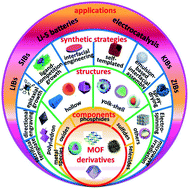Advances and challenges in metal–organic framework derived porous materials for batteries and electrocatalysis
Abstract
The development of advanced functional materials is of great significance for applications in energy storage and conversion fields. Metal–organic framework (MOF) derived porous materials have attracted extensive attention due to their high porosity, complex components and controllable structures. Although considerable achievements have been made in the controllable synthesis of multifunctional MOF derivatives, their systematic synthesis and applications in new-style energy storage and conversion devices (e.g. sodium ion batteries, potassium ion batteries, zinc ion batteries and fuel cells) have rarely been reviewed in depth. Given that materials' structures are highly dependent on the particular synthetic strategy and determine the final physical and chemical performances, a comprehensive insight into the latest advances in complex MOF-derived porous materials is provided in this review. The versatile architectures of functional materials and their influences on properties are clearly summarized. The advantages of the MOF-derived route over traditional non-MOF methods are highlighted. In the end, the challenges and the prospective research direction of MOF-derived functional materials in energy storage and conversion fields are proposed. The strategy–structure–property relationships in this review will provide scientific evidence on the reasonable design of high-efficiency MOF-derived functional materials for new energy systems.



 Please wait while we load your content...
Please wait while we load your content...